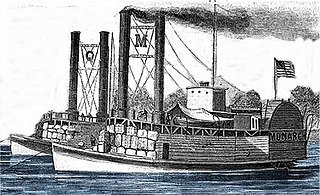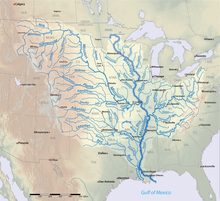
CSS Arkansas was the lead ship of her class of two casemate ironclads built for the Confederate States Navy during the American Civil War. Completed in 1862, she saw combat in the Western Theater when she steamed through a United States Navy fleet at Vicksburg in July. Arkansas was set on fire and destroyed by her crew after her engines broke down several weeks later. Her remains lie under a levee above Baton Rouge, Louisiana at 30°29′14″N91°12′5″W.

The Battle of Arkansas Post, also known as Battle of Fort Hindman, was fought from January 9 to 11, 1863, near the mouth of the Arkansas River at Arkansas Post, Arkansas, as part of the Vicksburg Campaign of the American Civil War. Confederate forces had constructed a fort known as Fort Hindman near Arkansas Post in late 1862. In December of that year, a Union force under the command of Major-General William T. Sherman left for an expedition against Vicksburg, without Major-General John A. McClernand because neither Major-Generals Henry Halleck nor Ulysses S. Grant trusted McClernand. After Sherman's force was repulsed at Chickasaw Bayou, McClernand arrived and took command from Sherman in January 1863.

The Vicksburg campaign was a series of maneuvers and battles in the Western Theater of the American Civil War directed against Vicksburg, Mississippi, a fortress city that dominated the last Confederate-controlled section of the Mississippi River. The Union Army of the Tennessee under Major General Ulysses S. Grant gained control of the river by capturing this stronghold and defeating Lieutenant General John C. Pemberton's forces stationed there.

USS Tyler was originally a merchant ship named A. O. Tyler, a commercial side-wheel steamboat with twin stacks and covered paddles positioned aft. Constructed in Cincinnati, Ohio in 1857, it was acquired by the United States Navy, 5 June 1861 for service in the American Civil War and converted into the gunboat USS Tyler on 5 June 1861. She was commissioned in September 1861. She was protected with thick wooden bulwarks.

The USS Queen of the West was a sidewheel steamer ram ship and the flagship of the United States Ram Fleet and the Mississippi Marine Brigade. It was built at Cincinnati, Ohio in 1854. It served as a commercial steamer until purchased by Colonel Charles Ellet Jr. in 1862 and converted for use as a ram ship. The ship operated in conjunction with the Mississippi River Squadron during the Union brown-water navy battle against the Confederate River Defense Fleet for control of the Mississippi River and its tributaries during the American Civil War.

The Battle of Chickasaw Bayou, also called the Battle of Walnut Hills, fought December 26–29, 1862, was the opening engagement of the Vicksburg Campaign during the American Civil War. Confederate forces under Lt. Gen. John C. Pemberton repulsed an advance by Union Maj. Gen. William T. Sherman that was intended to lead to the capture of Vicksburg, Mississippi.

The United States Ram Fleet was a Union Army unit of steam powered ram ships during the American Civil War. The unit was independent of the Union Army and Navy and reported directly to the Secretary of War, Edwin M. Stanton. The ram fleet operated in coordination with the Mississippi River Squadron during the Union brown-water navy battle against the Confederate River Defense Fleet for control of the Mississippi River and its tributaries.
USS Glide was a sternwheel steamer that served as a tinclad warship during the American Civil War. Built in 1862, she was purchased for military service late that year by the Union Navy. After being converted to a tinclad and armed with six 24-pounder Dahlgren guns, she entered service with the Mississippi River Squadron in early January 1863. Later that month, she saw action in the Battle of Arkansas Post, firing on Confederate-held Fort Hindman. Sent the next month to Cairo, Illinois, for repairs, Glide was destroyed in a fire of uncertain origin on February 7.

USS Marmora was a sternwheel steamer that served in the Union Navy during the American Civil War. Marmora was built in 1862 at Monongahela, Pennsylvania, as a civilian vessel, and was purchased for military service on September 17. Commissioned on October 21, the vessel served on the Yazoo River beginning the next month. She encountered Confederate naval mines on the Yazoo on December 11, and was present the next day when the ironclad USS Cairo was sunk by two mines. After further service on the Yazoo during the Battle of Chickasaw Bayou in late December, Marmora was assigned in January 1863 to a fleet that was preparing to operate against Confederate Fort Hindman, but was not present when the fort surrendered on January 11.

The Battle of Grand Gulf was fought on April 29, 1863, during the American Civil War. As part of Major General Ulysses S. Grant's Vicksburg campaign, seven Union Navy ironclad warships commanded by Admiral David Dixon Porter bombarded Confederate fortifications at Grand Gulf, Mississippi. One of the Confederate fortifications, named Fort Wade, was silenced, but the other, named Fort Cobun, continued firing. Due to the strong Confederate resistance, Grant and Porter decided it was not feasible to make an amphibious landing at Grand Gulf, but later landed at Bruinsburg, Mississippi, instead. After the Confederates were defeated at the Battle of Port Gibson on May 1, Grand Gulf was rendered indefensible and the fortifications were abandoned. The defenders of Grand Gulf then fought at the Battle of Champion Hill on May 16 and the Battle of Big Black River Bridge on May 17, before the start of the Siege of Vicksburg, which ended with a Confederate surrender on July 4. Today, the battlefield is preserved in Grand Gulf Military State Park, which was listed on the National Register of Historic Places in 1972.

The Battle of St. Charles was fought on June 17, 1862, at St. Charles, Arkansas, during the American Civil War. Earlier in 1862, a Union Army force commanded by Major General Samuel R. Curtis moved against Little Rock, Arkansas, but became bogged down in the Batesville area due to lack of supplies. The Union leadership decided to send a naval force from Memphis, Tennessee, up the White River to resupply Curtis's men. Major General Thomas C. Hindman, the Confederate commander in Arkansas, had fortifications constructed near St. Charles to stop the Union movement. Two artillery positions were built, and three ships, including CSS Maurepas, were scuttled to obstruct the river.

USS Monarch was a United States Army sidewheel ram that saw service in the American Civil War as part of the United States Ram Fleet and the Mississippi Marine Brigade. She operated on the Mississippi River and Yazoo River during 1862 and 1863.

USS Signal – a small 190-ton steamship – was acquired during the second year of the American Civil War by the Union Navy and outfitted as a gunboat. She also served other types of duty, such as that of dispatch vessel and convoy escort.

The Mississippi Marine Brigade was a Union Army amphibious unit which included the United States Ram Fleet and operated from November 1862 to August 1864 during the American Civil War. The brigade was established to act swiftly against Confederate forces operating near the Mississippi River and its tributaries. The brigade was commanded by Brigadier General Alfred W. Ellet and operated in coordination with the Mississippi River Squadron during the Union brown-water navy battle against the Confederate River Defense Fleet and land based forces. The brigade was independent of the Union Army and Navy and reported directly to the Secretary of War, Edwin M. Stanton. Despite the name, it was never part of the United States Marine Corps.
USS Curlew was a Union Navy stern-wheel steamer that saw service during the American Civil War. Built in 1862 in Pennsylvania as a civilian vessel, she was purchased by the Union Navy on December 17, 1862. Converted into a tinclad gunboat, she saw service from 1863 to 1865, often serving on the Mississippi River, the Ohio River, and the Tennessee River. In May 1863, she was involved in a minor action against Confederate forces on the Mississippi River off of the shore of Arkansas. July saw Curlew take part in an expedition up the Red River of the South, the Tensas River, the Black River, and the Ouachita River that captured two steamers and destroyed two more and a sawmill. On May 24, 1864, she dueled with Pratt's Texas Battery while on the Mississippi River, and on November 4 of that same year, was near the action of the Battle of Johnsonville but was unable to join the fighting. Decommissioned on June 5, 1865, she was sold in mid-August and her further career is unknown.

USS Rattler was a steamer acquired by the Union Navy during the American Civil War.
USS Juliet was a steamer acquired by the Union Navy during the American Civil War. She was used by the Union Navy as a gunboat in support of the Union Navy blockade of Confederate waterways.

The Yazoo Pass expedition was a joint operation of Major General Ulysses S. Grant's Army of the Tennessee and Rear Admiral David D. Porter's Mississippi River Squadron in the Vicksburg campaign of the American Civil War. Grant's objective was to get his troops into a flanking position against the Rebel defenders. The expedition was an effort to bypass the Confederate defenses on the bluffs near the city by using the backwaters of the Mississippi Delta as a route from the Mississippi River to the Yazoo River. Once on the Yazoo, the Army would be able to cross the river unopposed and thus achieve their goal. The operation would require a deep penetration into enemy territory that was dominated by water, so cooperation between the two services was necessary. The Army was led by Brigadier General Leonard F. Ross. Naval commander was Lieutenant Commander Watson Smith, who was in extremely poor health; his health was an important factor in the ultimate failure of the expedition.

Black Terror was a fake warship used in the American Civil War to bluff Confederate forces into destroying the partially-salvaged remains of the ironclad USS Indianola. Union forces were advancing to control the Mississippi River and had made two attempts to capture Vicksburg, Mississippi, in 1862. Early the next year, the ram USS Queen of the West moved downriver to interfere with Confederate shipping on the Red River; Indianola was sent down a few days later. However, Queen of the West was disabled and captured after an encounter with Confederate field fortifications, and Indianola was severely damaged on February 24 after an attack by the repaired Queen of the West and CSS William H. Webb.
CSS Maurepas was a sidewheel steamer that briefly served as a gunboat in the Confederate States Navy during the American Civil War. Built in 1858 in Indiana as Grosse Tete, the vessel was used in commercial trade until 1860 and then delivered mail until 1861, when she was acquired by the Confederate Navy.


















